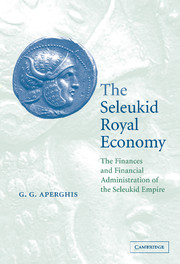Book contents
- Frontmatter
- Contents
- List of figures
- List of tables
- Preface
- List of abbreviations
- Map. The Hellenistic Near East
- Introduction
- Part I PRELIMINARIES
- Part II THE UNDERLYING ECONOMY
- Part III THE ROYAL ECONOMY
- Chapter 7 PS.-Aristotle's Oikonomika, Book 2
- Chapter 8 Revenue
- Chapter 9 The handling of surpluses
- Chapter 10 Expenditure
- Chapter 11 Coinage
- Chapter 12 A model of the Seleukid economy
- Chapter 13 Financial administration
- General conclusions
- Appendix I Coin hoards lists
- Appendix 2 Documents and translations
- References
- Index
Chapter 12 - A model of the Seleukid economy
from Part III - THE ROYAL ECONOMY
Published online by Cambridge University Press: 22 September 2009
- Frontmatter
- Contents
- List of figures
- List of tables
- Preface
- List of abbreviations
- Map. The Hellenistic Near East
- Introduction
- Part I PRELIMINARIES
- Part II THE UNDERLYING ECONOMY
- Part III THE ROYAL ECONOMY
- Chapter 7 PS.-Aristotle's Oikonomika, Book 2
- Chapter 8 Revenue
- Chapter 9 The handling of surpluses
- Chapter 10 Expenditure
- Chapter 11 Coinage
- Chapter 12 A model of the Seleukid economy
- Chapter 13 Financial administration
- General conclusions
- Appendix I Coin hoards lists
- Appendix 2 Documents and translations
- References
- Index
Summary
In previous chapters population, production and exchange, royal revenue and expenses and coinage were treated separately. Logically there should be certain relationships between these different elements of the Seleukid economy.
A very approximate model will be developed. Using source material and a measure of common sense, the magnitude of each factor of the economy will be estimated independently of the others and plausible relationships will also be found independently between them. Then if all the relationships actually hold between all the estimates, the model might be considered a reasonable one, since the several parameters involved will have been derived independently and the possibility that they could fit together in this way by chance is unlikely.
POPULATION
It will be useful to retain some ‘best estimates’ of population from chapter 4. The Seleukid empire at its peaks c. 281 bc and c. 190 bc probably contained between fourteen and eighteen million inhabitants, compared to between perhaps twenty-five and thirty million in Alexander's empire at the time of his death. Mesopotamia's population was estimated at four to five million, northern Syria's at up to one and a half million by the middle of the third century bc and perhaps even two million by the middle of the second, Judaea's at just under a quarter of a million, while the inhabitants of Egypt at this time may have numbered between three and three and a half million.
- Type
- Chapter
- Information
- The Seleukid Royal EconomyThe Finances and Financial Administration of the Seleukid Empire, pp. 247 - 262Publisher: Cambridge University PressPrint publication year: 2004



